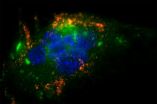A breast cancer drug to fight fungal disease?
2014-02-11
(Press-News.org) The drug tamoxifen appears to kill a fungus associated with a deadly brain infection that afflicts HIV/AIDS patients, according to a University of Rochester study published online today by mBio, the journal of the American Society for Microbiology.
The findings, by Damian J. Krysan, M.D., Ph.D., associate professor of Pediatrics and Microbiology and Immunology at the UR School of Medicine and Dentistry, point to an example of Rochester researchers looking to repurpose older drugs by discovering new applications for secondary properties of the drug. In this case, investigators found that tamoxifen can interfere with a protein, calmodulin, allowing it to kill the cryptocuccus germ. Making modifications to tamoxifen in the laboratory also boosted its ability to work as an anti-fungal.
Cryptococcus is responsible for about 1 million new infections and 620,000 annual deaths worldwide. It appears in the brain as either pneumonia or meningoencephalitis. No substantial improvements in treatment have occurred in a half-century.
Additional animal experiments are needed, Krysan said, before scientists can design clinical trials or develop new anti-cryptococcal drugs based on the tamoxifen findings. Meanwhile, a group of cancer researchers led by Mark Noble, Ph.D., professor of Biomedical Genetics at the University of Rochester, has shown with preclinical data that tamoxifen – which is usually prescribed to treat early-stage, less-aggressive breast cancer in premenopausal women – might also work for more aggressive, triple-negative disease, or on brain cancer.
INFORMATION:
Krysan's research was funded by the National Institute of Allergy and Infectious Disease.
ELSE PRESS RELEASES FROM THIS DATE:
A new postal code for cancer
2014-02-11
This news release is available in German.
Scientists have discovered that a polymer can provide a key to get into tumors: Prof. Prasad Shastri, Director of the Institute of Macromolecular Chemistry and core member of the cluster of excellence BIOSS Centre for Biological Signalling Studies at the University of Freiburg, and graduate students Julia Voigt and Jon Christensen have developed a new paradigm to home nanoparticles, containers that measure a few 100 nanometers in size, to endothelial cells. Using just charged polymers with the right affinity for cell lipids ...
Urban bees using plastic to build hives
2014-02-11
Once the snow melts, Canada's bee population will be back in business -- pollinating, making honey and keeping busy doing bee things. For at least two urban bee species, that means making nests out of plastic waste.
A new study by a University of Guelph graduate and a U of G scientist reveals that some bees use bits of plastic bags and plastic building materials to construct their nests. The research was published recently in the journal Ecosphere.
It's an important discovery because it shows bees' resourcefulness and flexibility in adapting to a human-dominated world, ...
MIT robot may accelerate trials for stroke medications
2014-02-11
The development of drugs to treat acute stroke or aid in stroke recovery is a multibillion-dollar endeavor that only rarely pays off in the form of government-approved pharmaceuticals. Drug companies spend years testing safety and dosage in the clinic, only to find in Phase III clinical efficacy trials that target compounds have little to no benefit. The lengthy process is inefficient, costly, and discouraging, says Hermano Igo Krebs, a principal research scientist in MIT's Department of Mechanical Engineering.
"Most drug studies failed and some companies are getting ...
First observation of a human HAT, key proteins in numerous pathologies
2014-02-11
The researcher Manuel Palacín, head of the Heterogenic and Multigenic Diseases lab at the Institute for Research in Biomedicine (IRB), in Barcelona, is among the world's experts in HATs (heteromeric amino acid transporters).
In humans, there are eight HAT molecules. These are associated, for example, with the following: rare diseases called aminoacidurias, such as lysinuric protein intolerance and cystinuria; the development of infections caused by the Kaposi sarcoma virus; various types of cancer; and relapse in cocaine use. HATs are, as the name implies, amino acid ...
Rare cancers: the challenge of accurate diagnosis -- press release
2014-02-11
Brussels, Belgium, 11 February 2014 -- Inaccurate diagnosis is a major obstacle for the proper treatment of patients with rare cancers. A Consensus on Improving the Pathologic Diagnosis of Rare Cancers was presented today by RARE CANCERS EUROPE, together with the European Society for Medical Oncology (ESMO) and the European Society of Pathology (ESP) in Brussels. The recommendations aim to help rare cancer patients get a timely and accurate diagnosis.
The statement is the result of a two-day workshop, where the particular challenges for each type of rare cancer(1) were ...
Could statins be used to fight a deadly viral infection?
2014-02-11
Two Perelman School of Medicine microbiologists may have found a way to use statins, the well-known blockbuster cholesterol-lowering drugs, to fight the hantavirus, a mysterious and lethal microorganism that appeared suddenly in the US southwest over 20 years ago. That first outbreak led to the deaths of more than a dozen people, most of them in their prime. The last reported outbreak happened in Yellowstone Park in 2012.
Only about 30 known human cases of hantavirus are reported in the US each year. The respiratory syndrome caused by a hantavirus infection comes from ...
Hacking the environment: bringing biodiversity hardware into the open
2014-02-11
New technologies are changing the way we collect biodiversity data. Data that once required taking expensive, bulky and fragile equipment on field trips can now be collected on cheap, compact and robust devices. In a recent paper in the Biodiversity Data Journal the construction of an environmental data-logger using the Arduino platform is described. It is hoped that this work will encourage the adoption of new data collection technologies by biodiversity scientists and foster new collaborations with both electronics hobbyists and electronics engineers who have an interest ...
Exon skipping prevents formation of toxic protein fragments in Huntington's disease
2014-02-11
New Rochelle, NY, February 11, 2014—An innovative therapeutic strategy for reducing the levels of toxic protein fragments associated with Huntington's disease uses a new approach called exon skipping to remove the disease-causing component of the essential protein, huntingtin. Proof of concept using antisense oligonucleotides to "skip over" the specific exon in a mouse model of Huntington's disease is reported in an article in Nucleic Acid Therapeutics, a peer-reviewed journal from Mary Ann Liebert, Inc., publishers. The article, part of a special focus issue on exon skipping, ...
Excess weight linked to brain changes that may relate to memory, emotions, and appetite
2014-02-11
Being overweight appears related to reduced levels of a molecule that reflects brain cell health in the hippocampus, a part of the brain involved in memory, learning, and emotions, and likely also involved in appetite control, according to a study performed by researchers at SUNY Downstate Medical Center and other institutions. The results of the study were published in Neuroimage: Clinical.
Jeremy D. Coplan, MD, professor of psychiatry at SUNY Downstate, led a multicenter team that visualized the molecule, N-acetyl-aspartate (NAA), using magnetic resonance spectroscopy, ...
RI Hospital: Cognitive behavioral therapy benefits patients with body dysmorphic disorder
2014-02-11
PROVIDENCE, R.I. – In a recent study, researchers at Rhode Island Hospital found significant benefits of cognitive behavioral therapy as a treatment modality for patients with Body Dysmorphic Disorder (BDD). BDD is a common, often severe, and under-recognized body image disorder that affects an estimated 1.7 percent to 2.4 percent of the population. This study demonstrated significant improvement in patients' BDD symptoms and level of disability, as well as high levels of patient satisfaction with the treatment. The study is published online in advance of print in the journal ...



